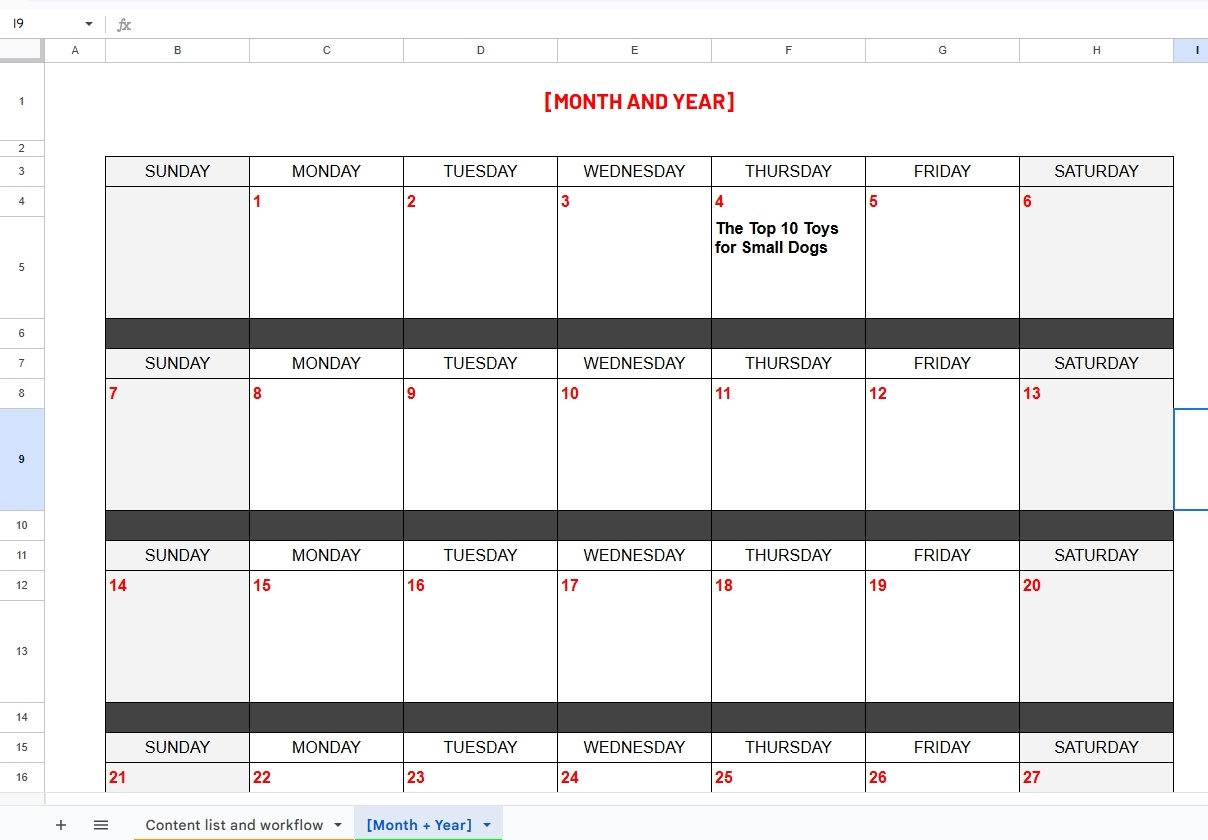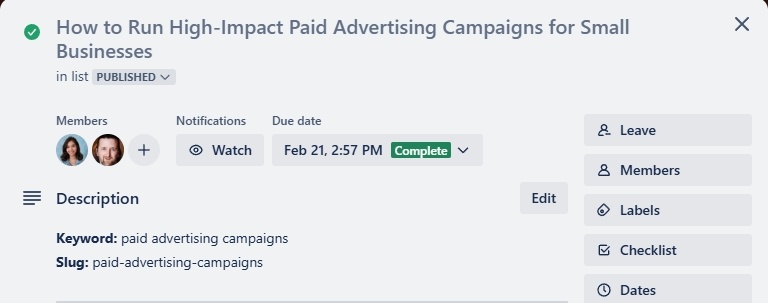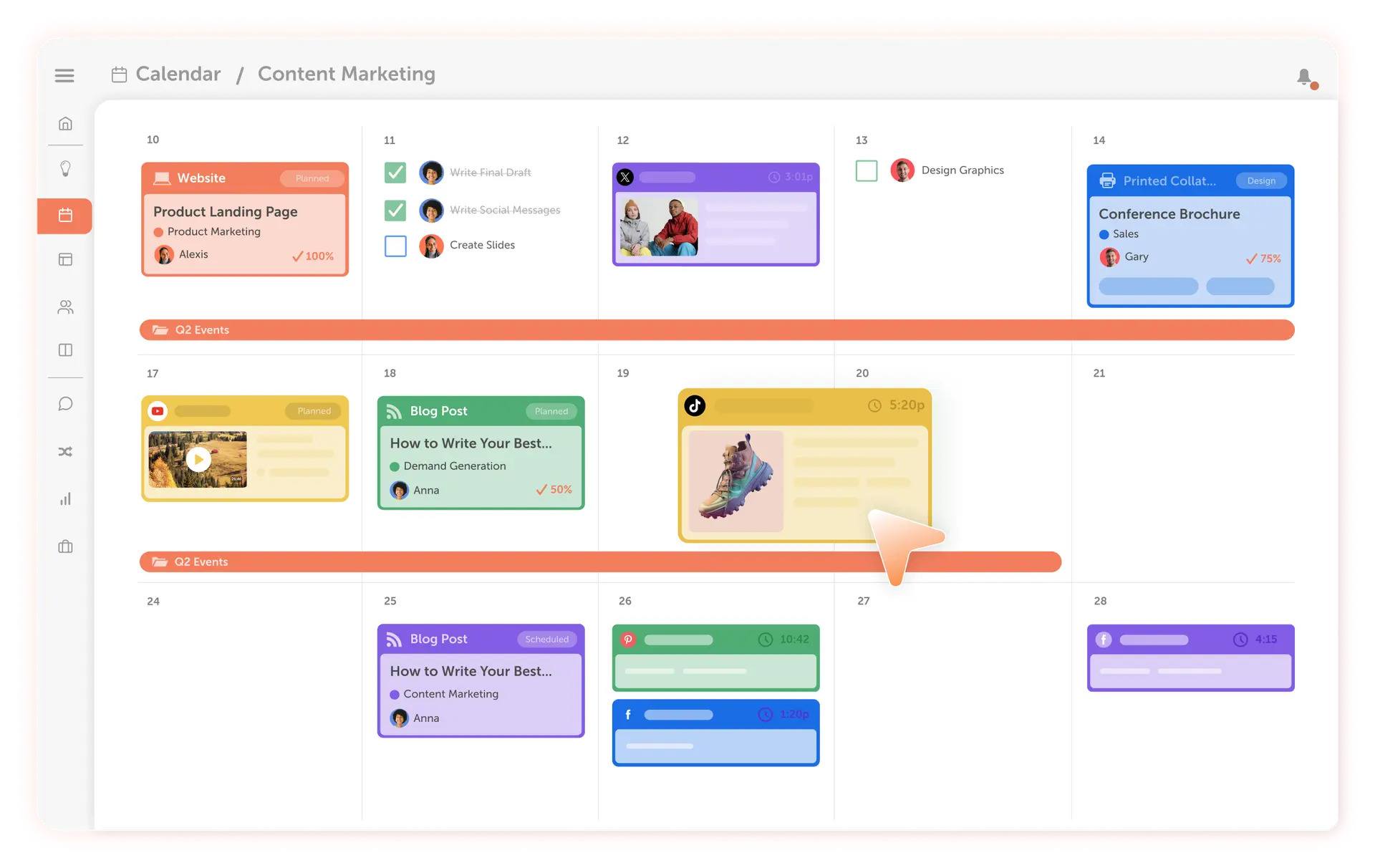Inconsistent content is one of the fastest ways to lose momentum with your audience—and fall short of your marketing goals.
When content is rushed, disorganized, or driven by last-minute decisions, it shows in your results.
On the other hand, content calendar planning gives you a system to eliminate the guesswork, and:
- Brings structure
- Supports strategic execution
- Ensures every piece you publish serves a purpose.
Whether you're managing content solo or leading a team, a well-structured calendar keeps everyone aligned and focused.
It’s the difference between scattered efforts and a streamlined, high-performing content engine.
This guide walks you through how to build a content calendar tailored to your goals, your workflow, and your audience—so you can publish with consistency and drive measurable impact…
Why a Content Calendar is Essential for Success
If content creation feels overwhelming, it's often because there's no system in place.
Content calendar planning provides the structure you need to operate strategically instead of reactively—and the data backs it up:
- According to the Content Marketing Institute, marketers who plan their content are 60% more likely to succeed.
- CoSchedule goes even further, finding that marketers who use a content calendar are 3x more likely to succeed.
Either way, it’s clear that using a content calendar greatly increases your chances of positive results.
It’s a simple shift that leads to more focused, effective content creation, bringing order, intention, and efficiency to your content workflow.
Inconsistent content is one of the fastest ways to lose momentum with your audience—and fall short of your marketing goalsClick To Post OnHere’s how it transforms your process:
Consistent Publishing That Builds Trust
Audiences expect regular, relevant content. A calendar keeps your publishing on schedule, reinforcing brand visibility and credibility over time.
Efficient Workflows That Save Time
No more scrambling for last-minute ideas. With a clear calendar, you can plan ahead, batch production, and reduce stress—especially when juggling multiple channels.
Content That Aligns With Business Goals
Your calendar becomes a strategic tool—not just a schedule. Use it to map content around product launches, seasonal campaigns, and key marketing objectives.
Better Team Collaboration
For teams, a centralized content calendar keeps writers, designers, and marketers in sync. Everyone knows what’s coming up, what they’re responsible for, and when it’s due.
When you treat your calendar as a planning system—not just a checklist—you make content a strategic asset.
It’s how high-performing marketing teams stay ahead and deliver consistent results.
Choosing the Right Content Calendar Tool
Not all content calendars are created equal—and the right tool depends on your team structure, content volume, and collaboration needs.
Whether you're managing content solo or leading a growing team, choosing the right platform sets the foundation for a scalable and efficient content operation.
Content calendar planning eliminates guesswork by bringing structure, supporting strategic execution, and ensuring every piece you publish serves a clear purpose.Click To Post OnHere’s a breakdown of the most effective options:
Spreadsheets (Google Sheets, Excel)
Solo marketers or small teams needing a simple, flexible solution.
Spreadsheets are the most accessible starting point.
They allow for easy customization, quick edits, and basic tracking of ideas, deadlines, and distribution.

Pros:
- Free and easy to set up
- Fully customizable to your workflow
- Ideal for planning across multiple channels in one view
Cons:
- No built-in notifications or automation
- Can become cluttered as your content volume increases
- Limited collaboration features for larger teams
Project Management Tools (Trello, Asana, Notion)
Teams needing better visibility and task delegation.
These tools combine task management with content planning, making it easier to assign responsibilities, track progress, and visualize workflows.

Pros:
- Designed for collaboration with task assignments and due dates
- Visual boards and timelines improve project clarity
- Integrates with calendars and communication tools
Cons:
- Some tools have a learning curve
- May feel overly complex for solo use
- Advanced features often require a paid plan
Dedicated Content Calendar Platforms (CoSchedule, Airtable, ClickUp)
Scaling teams and agencies managing high volumes of content.
Purpose-built platforms provide deep functionality—from automation and analytics to content approvals and integrations with your marketing stack.

Pros:
- Tailored for content planning and publishing
- Includes automation, performance tracking, and team workflows
- Syncs easily with tools like WordPress, HubSpot, or social schedulers
Cons:
- Higher cost compared to basic tools
- Initial setup can take time
- May offer more features than needed for smaller teams
Choose the tool that fits your current workflow—but think ahead. As your content operation scales, investing in a more robust system early can save time and headaches down the road.
Defining Your Content Strategy and Goals
Before you can fill out your content calendar, you need a clear content strategy to guide it.
Without strategic direction, you risk producing content that’s inconsistent, off-brand, or disconnected from business goals.
Here’s how to ground your calendar in purpose and performance:
1. Identify Your Content Pillars
Content pillars are your core themes—the foundational topics that support your brand narrative and resonate with your audience.
- A SaaS company might focus on productivity tips, workflow automation, and industry trends.
- A digital agency might publish on paid media, creative strategy, and client case studies.
Define 3–5 pillars that reflect what your audience cares about most—and what drives your business forward.
Start with 3–5 core content pillars that directly align with what your audience values most—and what drives your business forward.Click To Post On2. Set Your Posting Frequency
How often can your team realistically publish high-quality content?
Daily may sound ideal, but consistency matters more than volume.
Start with a sustainable cadence (e.g., weekly blog posts or biweekly newsletters) and scale as your workflow allows.
Use data from past performance to guide your decision—look at engagement and conversions, not just volume.
3. Choose the Right Content Formats
Different audiences engage with different formats. Choose a mix based on your goals, resources, and platforms:
Repurpose strategically to extend your reach without creating from scratch every time.
4. Align With Key Dates and Events
Your calendar should reflect more than just publishing frequency.
Map your content around:
Planning ahead lets you capitalize on peak moments with content that’s timely, relevant, and campaign-aligned.
Structuring Your Content Calendar for Maximum Productivity
A well-structured content calendar does more than keep your publishing on track—it becomes the operational hub of your content strategy.
When built effectively, it gives you a clear line of sight across content types, deadlines, owners, and performance goals.
What to Include
Here’s what to include for a streamlined, results-driven setup:
A clear, working title helps define the scope and purpose of each piece. Use this as a placeholder during planning and refine it before publishing.
Identify the format—blog post, video, podcast, social post, email, etc. This helps with resource planning and distribution strategy.
Who is this content for, and what’s the objective? (e.g., awareness, lead generation, engagement). Clarifying this upfront ensures alignment with your funnel and business goals.
Assign dates for each phase—drafting, review, approval, and publishing. This keeps production moving smoothly, especially across teams.
List where the content will be promoted: website, LinkedIn, email, YouTube, etc. Planning distribution alongside creation helps extend your content’s reach.
Organize With Color Coding and Categories
Use color labels or tags to segment by:
This makes it easy to scan your calendar and understand what’s in the pipeline at a glance.
Build Approval Workflows (For Teams)
Assign roles for each stage: who writes, who reviews, who publishes.
Tools like Trello, ClickUp, or Airtable allow you to set automated reminders and approval stages—minimizing bottlenecks and confusion.
Your content calendar should be more than tasks and deadlines — it should show ownership, goals, target audiences, and success metrics at a glance.Click To Post OnCreating a Sustainable Content Production Workflow
Even the best calendar falls flat without a reliable process behind it.
To maintain consistency without overwhelming your team, you need a content production workflow that prioritizes efficiency, reuse, and automation.
Here’s how to make your content calendar sustainable over the long term:
1. Batch Content Creation
Group similar tasks together to save time and boost creative focus.
- Outline multiple blog posts in one session
- Record several short-form videos back-to-back
- Design social graphics for the month in one go
Batching helps reduce context switching and makes your content creation sessions more productive.
2. Repurpose Your Content Strategically
Maximize ROI on every piece you create.
A single blog post can become:
Create once, distribute often. Repurposing keeps your content calendar full without needing to start from scratch.
3. Automate Publishing and Scheduling
Use automation tools to reduce manual work and keep your calendar running—even when your team is focused elsewhere.
Tools like:
- Buffer, Hootsuite, or Later for social scheduling
- WordPress or HubSpot for scheduled blog publishing
- Mailchimp or ActiveCampaign for automated email delivery
Automating distribution ensures consistent delivery without the need for daily check-ins.
Tracking Performance and Adjusting Your Content Calendar
Publishing content is only half the job. To truly drive results, you need to track what’s working, learn from the data, and refine your content calendar based on real performance—not assumptions.
Here’s how to turn insights into impact:
Use tools like Google Analytics, social media insights, and email marketing platforms to track key performance indicators (KPIs) such as:
- Page views and time on page
- Engagement rates (likes, shares, comments)
- Conversion rates (sign-ups, downloads, purchases)
This helps you identify which content types, topics, and channels drive the most value.
Look for content that consistently performs well—then build on it. For example:
- Republish and refresh blog posts that attract ongoing search traffic
- Expand a popular post into a gated guide or webinar
- Use top-performing social posts to inspire long-form content
According to HubSpot, refreshing existing high-performing blog content increases traffic—so leverage what’s already working to extend your reach without starting from scratch.
Don’t let your content calendar become static. Use performance data to refine:
- Posting frequency and timing
- Formats and distribution channels
- Messaging, headlines, and CTAs
Even small tweaks—like changing when you publish or how you structure a post—can lead to significant gains in engagement and ROI over time.
Frequently Asked Questions
Why is a content calendar essential for success?
A content calendar provides structure for strategic content creation and significantly increases the likelihood of success, backed by data.
What are the benefits of using a content calendar?
Using a content calendar leads to consistent publishing, efficient workflows, content aligned with business goals, and better team collaboration.
How can I choose the right content calendar tool?
Choose a tool based on team structure, content volume, and collaboration needs—consider spreadsheets for simplicity, project management tools for visibility, or dedicated platforms for scalability.
Why is defining content pillars crucial for a content calendar?
Defining content pillars ensures alignment with audience interests and business goals, guiding content creation and maintaining consistency.
What elements should be included in a structured content calendar?
Include content title, type, target audience, publishing dates, distribution channels, color coding for organization, and approval workflows for effective content planning.
To Conclude
A content calendar is more than a schedule, but is a strategic tool that helps you stay consistent, aligned, and results-focused.
By defining clear goals, choosing the right tools, and building a sustainable workflow, you’ll move from reactive content creation to a reliable, high-performing system.
The more intentional you are with your content calendar planning, the more impactful your marketing will become.
So start planning with purpose, and confidence—build your content calendar today.




